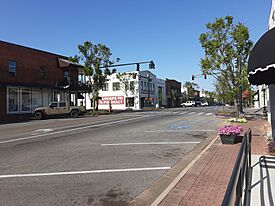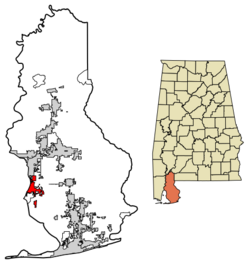Fairhope, Alabama facts for kids
Quick facts for kids
Fairhope
|
|||
|---|---|---|---|

Downtown Fairhope
|
|||
|
|||
| Motto(s):
"You've arrived"
|
|||

Location in Baldwin County, Alabama
|
|||
| Country | United States | ||
| State | Alabama | ||
| County | Baldwin | ||
| Founded | November 15, 1894 | ||
| Incorporated | April 25, 1908 | ||
| Government | |||
| • Type | Mayor–council | ||
| Area | |||
| • City | 14.53 sq mi (37.64 km2) | ||
| • Land | 14.47 sq mi (37.49 km2) | ||
| • Water | 0.06 sq mi (0.14 km2) | ||
| Elevation | 121 ft (37 m) | ||
| Population
(2020)
|
|||
| • City | 22,477 | ||
| • Estimate
(2022)
|
23,859 | ||
| • Density | 1,552.82/sq mi (599.53/km2) | ||
| • Urban | 76,807 | ||
| • Metro | 246,435 (US: 194th) | ||
| Time zone | UTC−6 (Central (CST)) | ||
| • Summer (DST) | UTC−5 (CDT) | ||
| ZIP codes |
36532-36533
|
||
| Area code(s) | 251 | ||
| Sales tax | 9.0% | ||
| GNIS feature ID | 0118120 | ||
Fairhope is a city in Baldwin County, Alabama, in the United States. It is located on the eastern side of Mobile Bay. In 2020, about 22,477 people lived there. Fairhope is a main city in the larger Daphne-Fairhope-Foley metropolitan area. This area includes all of Baldwin County.
Contents
History of Fairhope
Fairhope was started on November 15, 1894. It was built on the site of an older town called Alabama City. A group of 28 people who followed the ideas of economist Henry George founded it. They called themselves the Fairhope Industrial Association.
The Single-Tax Colony Idea
The founders wanted to create a special community. They aimed to be free from private monopolies. They also wanted everyone to have equal chances. Their goal was for people to keep the full reward of their hard work. They also believed in working together for common good.
To do this, they bought land on Mobile Bay. They then divided it into long-term leases. The group used the money from these leases to pay all government taxes. This system was meant to show how a "single-tax" idea could work. It aimed to encourage people to use land productively.
Fairhope's Place in Games and Education
"Fairhope Avenue" was even a property on an early board game. This game was called The Landlord's Game (from 1910). It was a game that came before the famous Monopoly.
In 1907, a teacher named Marietta Johnson started the School for Organic Education in Fairhope. This school was praised in a well-known book from 1915. The book was called Schools of Tomorrow by John Dewey. Both Dewey and Johnson helped start the Progressive Education Association.
Fairhope as a Creative Hub
Fairhope became a popular place for artists and thinkers to spend the winter. Famous visitors included writer Sherwood Anderson and lawyer Clarence Darrow. Other notable people like Wharton Esherick, Carl Zigrosser, and Upton Sinclair also visited.
The Fairhope Single-Tax Corporation still exists today. It manages over 4,000 acres of land. This land is both in and around the city of Fairhope. Over time, Fairhope has changed from a unique experiment to a popular resort town. It is now also a wealthy suburb of Mobile.
In 2019, the New York Times newspaper wrote about Fairhope. They called it "A Southern Town That’s Been Holding On to Its Charm, for More Than a Century."
Geography of Fairhope
Fairhope is located right on the shore of Mobile Bay. It is about 6 miles south of Daphne. It is also about 10 miles south of Spanish Fort. U.S. Route 98 (Greeno Road) runs through the city from north to south. The city sits on a gently sloping area.
The city covers a total area of about 14.53 square miles (37.64 square kilometers). Only a very small part of this area is water. The elevation of Fairhope goes from sea level at the bay up to 122 feet (37 meters) in the city center.
Climate in Fairhope
Fairhope has a humid subtropical climate. This means it has hot and humid summers. The winters are generally mild. Average temperatures in summer are around 90°F (32°C). In winter, they are around 50.4°F (10.2°C).
| Climate data for Fairhope, Alabama (1991–2020 normals, extremes 1917–present) | |||||||||||||
|---|---|---|---|---|---|---|---|---|---|---|---|---|---|
| Month | Jan | Feb | Mar | Apr | May | Jun | Jul | Aug | Sep | Oct | Nov | Dec | Year |
| Record high °F (°C) | 85 (29) |
88 (31) |
88 (31) |
97 (36) |
98 (37) |
103 (39) |
105 (41) |
103 (39) |
105 (41) |
97 (36) |
94 (34) |
89 (32) |
105 (41) |
| Mean daily maximum °F (°C) | 61.8 (16.6) |
65.4 (18.6) |
71.8 (22.1) |
77.9 (25.5) |
85.0 (29.4) |
89.4 (31.9) |
91.1 (32.8) |
91.1 (32.8) |
88.2 (31.2) |
80.5 (26.9) |
71.0 (21.7) |
64.3 (17.9) |
78.1 (25.6) |
| Daily mean °F (°C) | 49.2 (9.6) |
52.6 (11.4) |
58.8 (14.9) |
64.9 (18.3) |
72.6 (22.6) |
78.5 (25.8) |
80.3 (26.8) |
80.0 (26.7) |
76.5 (24.7) |
67.4 (19.7) |
57.6 (14.2) |
51.7 (10.9) |
65.8 (18.8) |
| Mean daily minimum °F (°C) | 36.6 (2.6) |
39.8 (4.3) |
45.9 (7.7) |
51.9 (11.1) |
60.3 (15.7) |
67.5 (19.7) |
69.6 (20.9) |
69.0 (20.6) |
64.7 (18.2) |
54.3 (12.4) |
44.2 (6.8) |
39.1 (3.9) |
53.6 (12.0) |
| Record low °F (°C) | 5 (−15) |
10 (−12) |
19 (−7) |
29 (−2) |
29 (−2) |
52 (11) |
58 (14) |
60 (16) |
41 (5) |
32 (0) |
21 (−6) |
8 (−13) |
5 (−15) |
| Average precipitation inches (mm) | 5.48 (139) |
4.65 (118) |
5.06 (129) |
5.51 (140) |
4.93 (125) |
6.78 (172) |
9.03 (229) |
7.16 (182) |
6.60 (168) |
4.38 (111) |
4.57 (116) |
5.16 (131) |
69.31 (1,760) |
| Average precipitation days (≥ 0.01 in) | 10.9 | 9.6 | 9.0 | 7.5 | 8.1 | 12.6 | 14.4 | 15.0 | 10.9 | 7.1 | 7.7 | 10.5 | 123.3 |
| Source: NOAA | |||||||||||||
People in Fairhope (Demographics)
| Historical population | |||
|---|---|---|---|
| Census | Pop. | %± | |
| 1910 | 590 | — | |
| 1920 | 853 | 44.6% | |
| 1930 | 1,549 | 81.6% | |
| 1940 | 1,845 | 19.1% | |
| 1950 | 3,354 | 81.8% | |
| 1960 | 4,858 | 44.8% | |
| 1970 | 5,720 | 17.7% | |
| 1980 | 7,286 | 27.4% | |
| 1990 | 8,485 | 16.5% | |
| 2000 | 12,480 | 47.1% | |
| 2010 | 15,326 | 22.8% | |
| 2020 | 22,477 | 46.7% | |
| 2022 (est.) | 23,859 | 55.7% | |
| U.S. Decennial Census 2020 Census |
|||
Fairhope's Population in 2020
In 2020, the census counted 22,477 people living in Fairhope. There were 7,790 households and 5,606 families. Most people in Fairhope are White (86.56%). Other groups include Black or African American (4.82%), Asian (0.9%), and Native American (0.27%). About 3.84% of the population was Hispanic or Latino.
Fairhope's Population in 2010
In 2010, the census showed 15,326 people lived in the city. There were 6,732 households. About 25.9% of these households had children under 18. The average age of people in Fairhope was 46 years old.
Education in Fairhope
Fairhope has several schools for students of all ages.
Public Schools
Fairhope's public schools are part of the Baldwin County Public Schools system:
- Fairhope High School (grades 9–12) – It has about 1,575 students. The principal is Jon Cardwell.
- Fairhope Middle School (grades 7–8) – It has about 802 students. The principal is Angie Hall.
- J. Larry Newton School (grades K–6) – It has about 769 students. The principal is Patrice Krueger.
- Fairhope West Elementary School (grades K-6) – It has about 1,011 students.
- Fairhope East Elementary School (grades K-6) – It has about 725 students.
Other Schools
Other schools in Fairhope include:
- The Marietta Johnson School of Organic Education – This is a private school. It teaches students from 1st through 8th grades.
- St. Michael Catholic High School – This school started in 2016. It serves grades 9–12.
- Bayshore Christian School – This school started in 2002. It offers classes from Pre-Kindergarten to 12th grade.
- Faulkner State Community College – This college has a campus in Fairhope. It offers classes for adults and college courses.
- The University of South Alabama – This university also has a campus in Fairhope. It offers advanced college courses in subjects like education and nursing.
Transportation in Fairhope
BRATS, which stands for the Baldwin Regional Area Transit System, provides transit services in the county. This service is called "dial-a-ride."
Notable People from Fairhope
Many interesting people have lived in or are from Fairhope:
- Maude Balln, civil rights activist
- Pinky Bass, photographer
- Bob Baumhower, football player and businessman
- Rick Bragg, writer
- Jimmy Buffett, singer and songwriter
- Grayson Capps, singer songwriter
- Eugenia S. Chapman, educator and Illinois state representative
- Dave Edwards, musician
- Grant Enfinger, professional race car driver
- Fannie Flagg (Patricia Neal), author and actress
- Abbi Glines, writer
- Winston Groom, novelist (Forrest Gump)
- Fred Nall Hollis (Nall), artist
- Marie Howland, 19th century utopian and journalist
- Marietta Johnson, educator and reformer
- David King, former NFL defensive back
- Leon Lett, football player
- Dean Mosher, artist, author and historian
- George M. Murray, bishop in the Episcopal Church
- Burton Ritchie, entrepreneur
- Philip Rivers, former NFL quarterback
- Janie Shores, Alabama Supreme Court justice
- Anis Shorrosh (1933–2018), Palestinian Evangelical Christian author, speaker, and pastor
- Eddie Stanky, former Major League Baseball player and manager
- Dave Stapleton, former baseball player
- Thompson Square, country music duo
- Bill Varney, film sound editor
- Bob Weltlich, former college basketball coach
See also
 In Spanish: Fairhope (Alabama) para niños
In Spanish: Fairhope (Alabama) para niños



